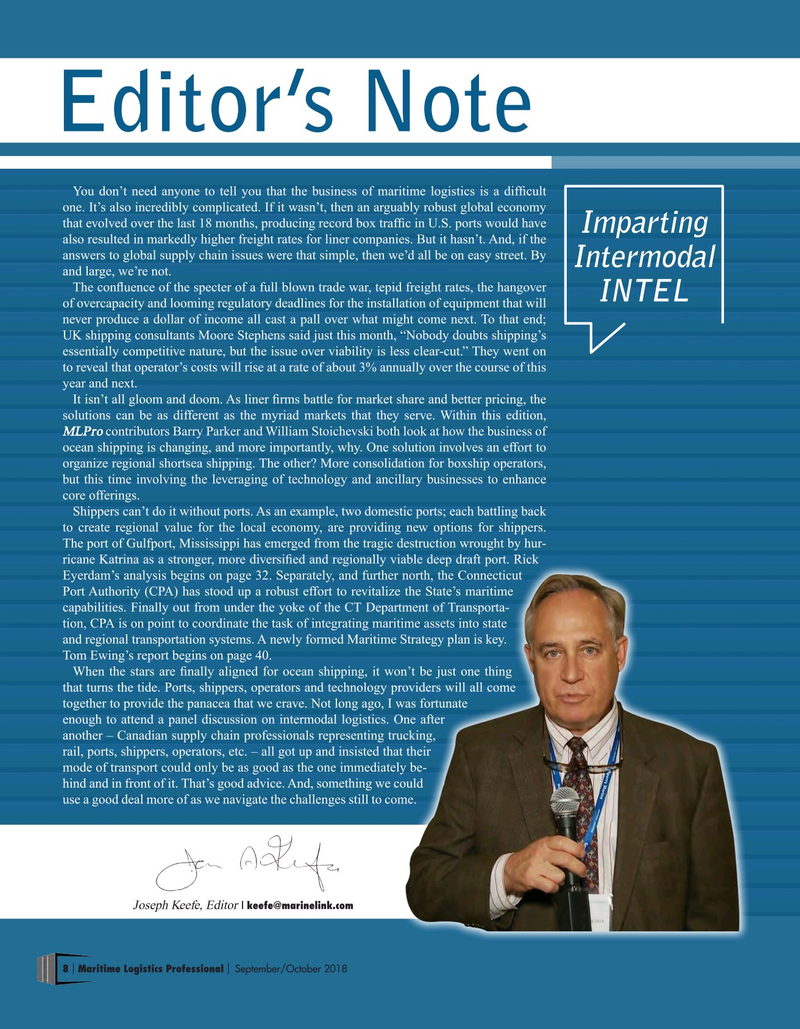
Page 8: of Maritime Logistics Professional Magazine (Sep/Oct 2018)
Liner Shipping & Logistics
Read this page in Pdf, Flash or Html5 edition of Sep/Oct 2018 Maritime Logistics Professional Magazine
Editor’s Note
You don’t need anyone to tell you that the business of maritime logistics is a diffcult one. It’s also incredibly complicated. If it wasn’t, then an arguably robust global economy that evolved over the last 18 months, producing record box traffc in U.S. ports would have
Imparting also resulted in markedly higher freight rates for liner companies. But it hasn’t. And, if the answers to global supply chain issues were that simple, then we’d all be on easy street. By
Intermodal and large, we’re not.
The confuence of the specter of a full blown trade war, tepid freight rates, the hangover
INTEL of overcapacity and looming regulatory deadlines for the installation of equipment that will never produce a dollar of income all cast a pall over what might come next. To that end;
UK shipping consultants Moore Stephens said just this month, “Nobody doubts shipping’s essentially competitive nature, but the issue over viability is less clear-cut.” They went on to reveal that operator’s costs will rise at a rate of about 3% annually over the course of this year and next.
It isn’t all gloom and doom. As liner frms battle for market share and better pricing, the solutions can be as different as the myriad markets that they serve. Within this edition,
MLPro contributors Barry Parker and William Stoichevski both look at how the business of ocean shipping is changing, and more importantly, why. One solution involves an effort to organize regional shortsea shipping. The other? More consolidation for boxship operators, but this time involving the leveraging of technology and ancillary businesses to enhance core offerings.
Shippers can’t do it without ports. As an example, two domestic ports; each battling back to create regional value for the local economy, are providing new options for shippers.
The port of Gulfport, Mississippi has emerged from the tragic destruction wrought by hur- ricane Katrina as a stronger, more diversifed and regionally viable deep draft port. Rick
Eyerdam’s analysis begins on page 32. Separately, and further north, the Connecticut
Port Authority (CPA) has stood up a robust effort to revitalize the State’s maritime capabilities. Finally out from under the yoke of the CT Department of Transporta- tion, CPA is on point to coordinate the task of integrating maritime assets into state and regional transportation systems. A newly formed Maritime Strategy plan is key.
Tom Ewing’s report begins on page 40.
When the stars are fnally aligned for ocean shipping, it won’t be just one thing that turns the tide. Ports, shippers, operators and technology providers will all come together to provide the panacea that we crave. Not long ago, I was fortunate enough to attend a panel discussion on intermodal logistics. One after another – Canadian supply chain professionals representing trucking, rail, ports, shippers, operators, etc. – all got up and insisted that their mode of transport could only be as good as the one immediately be- hind and in front of it. That’s good advice. And, something we could use a good deal more of as we navigate the challenges still to come.
Joseph Keefe, Editor | [email protected] 8 Maritime Logistics Professional September/October 2018 | |

 7
7

 9
9
